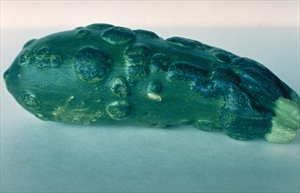Warts on cucurbits.
Pacific Pests, Pathogens and Weeds - Online edition
Pacific Pests, Pathogens & Weeds
Cucurbit warts (267)
Biotic causes (variety, viruses, insects) and abiotic causes (oedema).
Wherever cucurbits are grown.
Cucurbits - gourds, melons, pumpkins, squash, zucchini, and others.
There are three main reasons why pumpkins and squash have warts, and these are: (i) they are selected or bred for the characteristic; (ii) they are infected with viruses; and (iii) they have oedema, a non-biotic or physiological problem. A fourth, minor reason, is insects.
Selection and breeding
There are many varieties that produce warts: some are new, others are 'heirloom' (traditional varieties), but all produce warts naturally (Photos 1&2). There are seed companies that trade on this warty feature and have bred pumpkins and squash to produce warts in excess. These varieties are popular in the US from Halloween to Thanksgiving; they make colourful displays and historically they have significance as it is believed that the Pilgrim colonists grew them for their long storage, having been given seed by Native Americans. The warty ones add to the diversity of these varieties, with some being especially sweet and excellent for pumpkin bread, cheesecake and pie!
Oedema
Oedema (or edema) is caused by water imbalance in cool wet years, when the air is cooler than the soil, relative humidity is high and so too is soil moisture. Roots take up water faster than it can be used for plant growth or transpired. Pressure builds inside the plant; the cells enlarge and then burst. Later, the damaged areas heal, forming a scar that is dry, corky and raised on the underside of the leaves, petioles and stems, and on the fruits (Photos 3&4).
Viruses
There are four important mosaic viruses that affect cucurbits: Cucumber mosaic virus, Papaya ringspot virus (previously known as Watermelon mosaic virus 1), Zucchini yellow mosaic virus, and Watermelon mosaic virus. Papaya ringspot virus and Zucchini yellow mosaic virus both cause severe fruit distortions (Photo 5).
Cucumber, pumpkin, watermelon and zucchini fruit show a variety of symptoms, with yellow and green mottling, dark green knobbly warts on pale green fruit, or just knobbly outgrowths. Zucchini is particularly susceptible to Zucchini mosaic virus (see Fact Sheet no. 202) (Photo 5). All are spread by aphids. Cucumber mosaic virus is also spread by beetles.
Insects
Cucumber beetles (Diabrotica species) can cause damage to all cucurbits by feeding on flowers, leaves and fruits. Look under the pumpkin and at the top for signs of cucumber beetle damage. The damage is done by the beetles feeding on the fruit before the skin hardens, causing scaring and bumps on the surface. The beetles also spread bacterial diseases (Erwinia tracheiphila and Pseudomonas syringae pv. lachrymans), and viruses (Cucumber mosaic virus and Melon necrotic spot virus). They are present in North and Central America, but only in Guam among the Pacific islands.
Warts caused by oedema develop most often when the young fruit are enlarging. On pumpkin, the warts may disfigure the fruit so much that they become unmarketable. The viruses of concern are spread by aphids. Losses of 50% in terms of yield and reduced fruit quality may occur in watermelon, muskmelon (cantaloupe, honeydew), squash, and pumpkin when infection occurs early. Damage caused by insects is miner, and note Diabrotica does not occur in most Pacific island countries. It is recorded only from Guam.
Look for the outgrowths, knobs, bumps and warts on the fruits, often scattered randomly over the surface, or sometimes just on the surface facing the ground.
CULTURAL CONTROL
Oedema: The condition will stop when it becomes warmer and drier, but the warts already formed will remain. If oedema occurs other than when it is cool, cloudy and wet, there is need to look at irrigation practices. It may mean that the crops are being given too much water. The presence of oedema might also suggest that there are wet spots in the field, especially if the warts occur mostly on the side facing the ground (Photo 4). In that case, either drain the areas where oedema occurs or plant pumpkin and squash elsewhere.
Viruses: Infection can be reduced by good farm hygiene; do the following:
- Avoid overlapping cucurbit crops or, if not possible, plant as far away from older crops as possible.
- Use reflective plastic mulch to repel aphids from infesting the plants.
- Remove any plants with signs of virus infection.
- Weed to prevent aphids from moving into the fields to spread viruses from wild hosts.
RESISTENT VARIETIES
Most new varieties carry resistance to Cucumber mosaic virus. Consult current seed catalogues for information on tolerance of cucurbits to this and other virus diseases.
CHEMICAL CONTROL
If insecticides are necessary, use any of the following 'soft' insecticides on aphids, applied weekly until control is achieved:
- Soap sprays (5 tablespoons of soap in 4 litres water).
- Vegetable oil (1 cup cooking oil; 2 cups water; 1 teaspoon dishwashing liquid. Dilute the mixture at 3 teaspoons per half a litre of water and spray on the infested leaves).
- Commercial products with petroleum oil: follow the instructions on the product label.
For cucumber beetles, apply a synthetic pyrethroid spray to the plants, covering all sides of the foliage.
AUTHOR Grahame Jackson
Information (and Photo 3) from Lindsey du Toit Photo gallery of vegetable problems - Cucurbits. Pacific Northwest Vegetable Extension Group, Washington State University. (http://mtvernon.wsu.edu/path_team/squash.htm); and from (and Photo 4) Gerald Holmes. What are these bumps on my vegetables? Michigan State University Extension. (http://msue.anr.msu.edu/news/what_are_these_bumps_on_my_vegetables). Photos 1&2 Eric Boa, UK. Photo 5 Diseases of vegetable crops in Australia (2010). Editors, Denis Persley, et al. CSIRO Publishing.
Produced with support from the Australian Centre for International Agricultural Research under project PC/2010/090: Strengthening integrated crop management research in the Pacific Islands in support of sustainable intensification of high-value crop production, implemented by the University of Queensland and the Secretariat of the Pacific Community.








